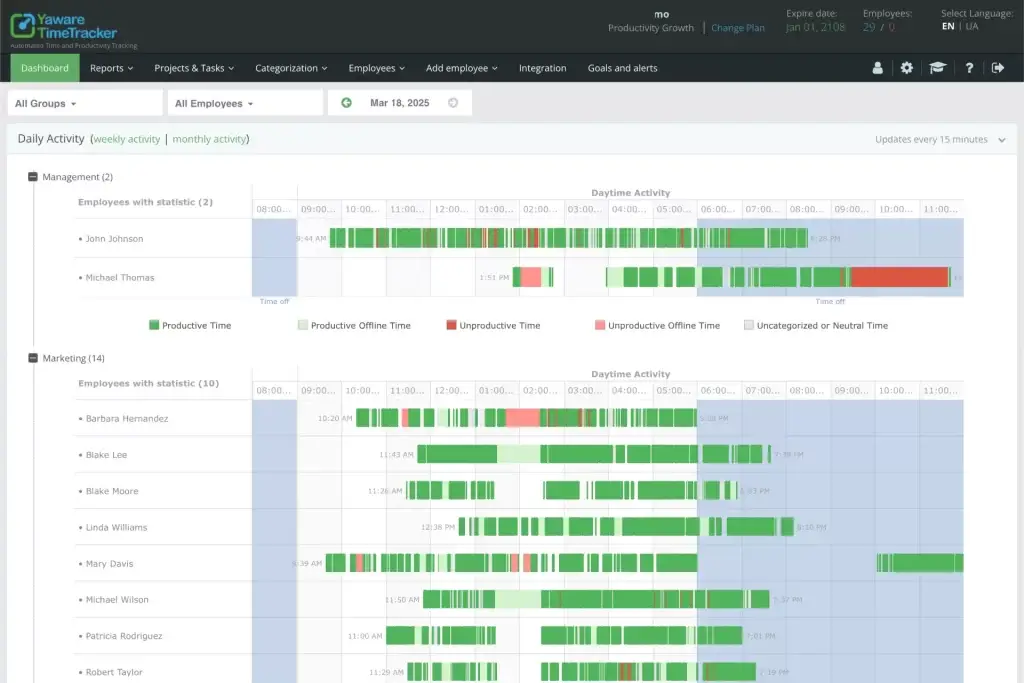When your star performer submits their resignation letter, it always feels sudden. The same goes for that unexpected project delay or the quarterly results that somehow fell short despite everyone “working hard.” But what if the warning signs were there all along — hiding in plain sight within your team's digital behavior patterns?
The uncomfortable truth for executives and team leaders: employee burnout rarely announces itself. It whispers through data long before it screams through turnover.
The Illusion of Engagement: Activity ≠ Productivity
You see it every day: calendars filled with meetings, tasks marked “in progress,” and messages flowing through communication channels. The dashboard looks reassuringly active. Yet something doesn't add up when deliverables are slower, innovation dips, or quality suffers.
This is the burnout paradox. Burnt-out employees often maintain the appearance of engagement while their meaningful output steadily declines. They're not disloyal or lazy — they're exhausted, disconnected, and going through the motions.

“We had a team that looked incredibly busy,” shares a CTO from a mid-size fintech company. “Everyone was online, responding quickly, attending every meeting. Yet our feature completion rate had dropped by 40%. When we finally analyzed their workflow data, we discovered they were just barely keeping up with communications — actual development time had practically disappeared.”
What Burnout Looks Like in Your Time Tracker
While traditional burnout assessment relies on self-reported surveys or managerial intuition, these methods often identify the problem too late. Modern time analytics reveals objective behavioral patterns that signal burnout long before an employee recognizes it themselves.
Here are the five most reliable indicators visible in Yaware.TimeTracker data:
- Declining deep work sessions
Healthy knowledge work requires sustained focus periods (typically 60-90 minutes). When deep work sessions fragment into 15-20 minute blocks or disappear entirely, it signals cognitive exhaustion. - Increasing context switching
Burnt-out employees often jump between applications at a significantly higher rate — sometimes 2-3x their normal baseline. This digital restlessness reflects difficulty maintaining attention and diminished cognitive resources. - Schedule inconsistency
Notice team members logging in progressively later or working increasingly irregular hours? This pattern often indicates sleep disruption and work-life boundary erosion — hallmarks of advancing burnout. - Migration to “neutral” applications
A telling sign: time increasingly shifts from high-value productivity tools to neutral applications like email, chat, and document processing. These activities feel productive but often represent low-cognitive-load busywork that burnt-out employees gravitate toward. - Expanding time-to-output ratio
Perhaps most critical: tasks that once took 3 hours now consume 5+ hours, with no change in complexity. This efficiency decline isn't about skill — it's about diminished cognitive capacity.
The Hard Data: What Burnout Really Looks Like
In a revealing analysis across multiple organizations, we discovered an alarming pattern. When employees begin experiencing burnout, their meaningful work output often drops to just 2-3 hours daily — despite being “active” for a full workday.
The remaining hours disappear into a scattered pattern of:
- Excessive messaging and email (reaction vs. creation)
- Brief, interrupted sessions across multiple applications
- Elongated transitions between tasks
- Extended “idle” periods during nominally active hours
One director of operations discovered this pattern when investigating why a previously high-performing team's output had declined: “The data showed everyone was ‘working' 9+ hours daily according to activity logs. But when we isolated actual focused work on deliverables, it averaged just 1.8 hours per person. They weren't slacking — they were struggling, spending enormous energy just to maintain basic functions.”
Why Even the Best Leaders Miss It
Even exceptional leadership teams frequently overlook burnout until it's critical. This occurs for three primary reasons:
First, most performance tracking focuses on lagging indicators — missed deadlines or declining output. By then, burnout has already taken hold.
Second, we confuse activity with productivity. When employees maintain communication responsiveness, it creates a reassuring illusion that substantive work continues normally.
Finally, burned-out employees themselves often don't recognize their condition. The gradual nature of cognitive decline means many continue pushing themselves while unconsciously shifting to lower-value activities that feel productive but deliver minimal impact.
Beyond Detection: What Effective Leaders Do Differently
The instinctive response to declining productivity might be tighter control or increased pressure. Data shows this approach accelerates burnout rather than solving it.
Organizations successfully addressing early-stage burnout take a different approach:
Increase visibility, not control
Use time analytics as a conversation starter, not a performance hammer. When leaders share objective data with team members about their fragmented focus time, it often produces revelations: “I had no idea I was only getting 90 minutes of deep work daily.”
Address the attention economy, not just workload
Many burnout interventions focus solely on reducing volume. More effective interventions also protect attention quality through meeting-free days, notification boundaries, and workflow redesigns.
Rebuild sustainable focus habits
Some organizations implement structured “focus protocols” where teams establish protected deep work time, backed by time analytics that confirm these periods actually occur and produce results.
A Chief People Officer who implemented this approach saw significant results: “Within six weeks of restructuring around focus time protection, we saw deep work sessions increase by 62%. More importantly, our quarterly pulse survey showed a 28% increase in sustainable workload perception — without reducing actual deliverables.”
From Burnout to Breakthrough
The most powerful insight from time analytics isn't just burnout detection — it's the revelation that many teams operate far below their potential cognitive capacity while feeling maximally busy.
This represents both challenge and opportunity. By identifying early burnout signals, leaders can intervene before losing key talent or project momentum. More importantly, they can rebuild work patterns that restore sustainable focus — creating environments where breakthrough performance coexists with wellbeing.
Your team is capable of extraordinary work, but not when they're running on cognitive fumes. The first step is seeing the reality behind the activity.
Want to identify the early signals of burnout in your team's data? Request a demo with Yaware.TimeTracker, and we'll analyze your team's actual work patterns to reveal focus opportunities and burnout risks before they impact your bottom line.

